![]()
One of the most
popular small US Army 'vehicles' of WW2 is without doubt the M3A4 Hand Cart.
A general misconception is that this was an Airborne item and only used by
paratroops. In fact the Cart was a standard Ordnance item used by every branch
of the US Army to haul ammunition and equipment.
Two carts could be transported in the back of the 2 1/2 Ton Trucks on the floor
of the bed between the rows of seated troops.
Many collectors say these carts were intended to be drawn by the Cushman Model
53 Airborne Scooter, but neither the Hand Cart manual, nor the Cushman manual
describe this. Furthermore these hand carts had been in use for many years
before the Cushman scooter was put into production and there are no WW2 pictures
showing this practice around...
Although the earliest Army carts were fitted with motorcycle wheels, they are completely different from the carts issued to the US Marine Corps, which were equipped with the larger 19" 'motorcycle style' rims. The latter were not used by the US Army during their European campaign.
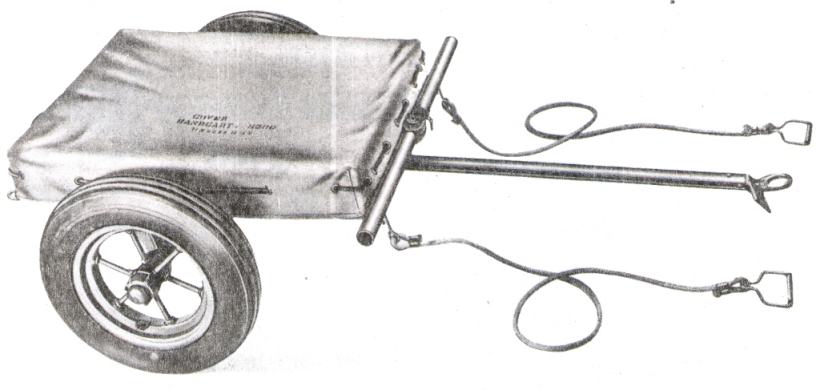
Hand Cart M3A4 with M500 Cover
and Tow Ropes as shown on the back cover of ORD9-SNL A-42, dated 1 June 1945
The US Army had
several different types and models of Carts in inventory over the years
preceding WW2 but during the war the most common model used in the ETO was the
M3A4.
The M3A4 was derived directly from the pre-war carts developed by the US Army
Infantry Board in the 1930s. These early carts were equipped with motorcycle
wheels and tires and were described in the July-August 1936 edition of the
Infantry Journal:
|
|
Hand
Carts for Infantry By mounting a certain set of clamps on the body we have an excellent cart for transporting the .30 caliber machine gun, with another set of clamps, the mortar company has hand transportation for the 81-mm. mortar; with a third set of clamps, the .50 caliber machine gun can be moved forward by cart; using no clamps, we have a general utility cart for communications equipment, mess supplies and the like. These carts were originally designed for motorized units. They are to be carried (loaded) in the trucks until the trucks can no longer proceed. The carts are then detrucked and the movement completed by hand. This cart is able to carry a much greater load than any other developed and yet its total weight is less. It is strong enough to carry an emergency pay load of 400 pounds, which means that the ammunition crew arrives at the gun with 400 pounds of ammunition and 80 pounds of cart, and not 300 pounds of cart and 200 pounds of ammunition. This
cart proved so satisfactory in experimental tests that the original
tongue was modified in order to make it of full use to animal-drawn
units. |
|
'Operation
Torch' |
|
GI's tow a cart loaded with gear along a North African road during Operation Torch, November 1942. The cart wheels are of the larger motorcycle style which indicates an pre-war (M3??) Utility Cart as described in the Infantry Journal above. Note the American flag painted on the side of the Stuart Tank and worn as brassards by the men hauling the cart. The display of 'Old Glory' was prominent during this operation. |
Early WW2
production carts kept the pre-war aluminum slatted box design but pretty soon
the carts were made with a full metal cargo body.
Except for some very early M3A4 Steel Bodied Carts which had a plain box
without re-inforcing at the top and no holes to attach brackets; the M3A4 Cart served as a basic cart which could be converted into other
models by bolting additional parts through the holes in the body provided for this
purpose.
The Model M4A1 was thus equipped with brackets for the transportation
of the M1917A1 water cooled Machine Gun, while the M5A1 was equipped with
brackets and straps to hold the .50Cal M2 HB Machine Gun and its M3 Tripod. The M6A1 was used to transport
the 81mm Mortar.
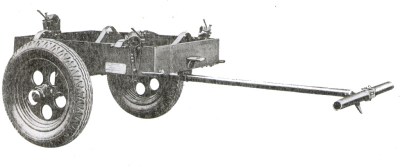
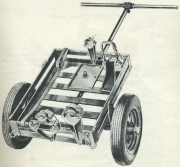
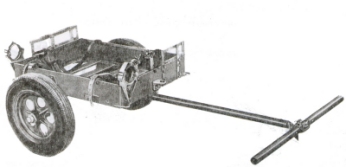
Hand Carts M4A1, M5A1 and M6A1 as
illustrated in ORD9-SNL A-42, dated 1 June 1945
Note the 'bolt on' parts and brackets that hold the tripod or mortar parts
All carts are equipped with aluminum wheels, easily identified by the round
holes in the rims and the M5A1 shown is the early pattern with aluminum slatted
box.
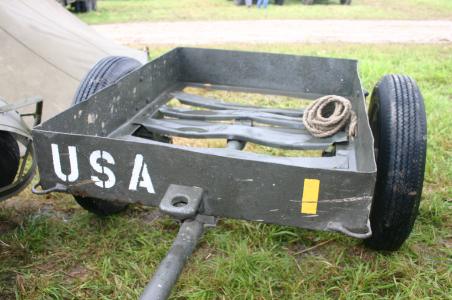
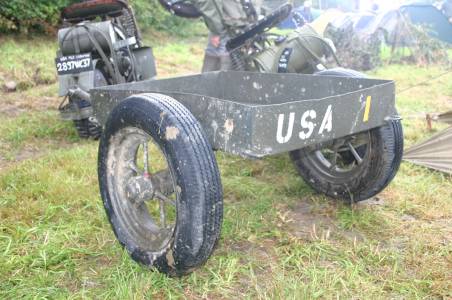
Although in bad shape, the cart
above is a rare example of an early M3A4 with plain box and no holes nor
re-inforcing rib around the top of the body. The above cart was made by the Rock
Island Arsenal and has Serial Number 8433. It was entered by a French owner in
the 2007 Beltring War & Peace Show.
The US Army's
Rock Island Arsenal was a main manufacturer of the early carts but as war
progressed other companies such as John Wood Mfg
Company, Trussbilt and Omaha Industries Inc also produced a considerable number
of carts.
Early Carts were completely made in
aluminum, but on later models a mix of steel and aluminum parts were used. The
early aluminum 5-hole rims were soon replaced with all steel spoke wheels. Different types of tires were mounted, and they seem to have been supplied
by the Firestone Tire Company and the Good-Year Tire Company.
Canvas Covers were provided for the different carts (M500-M501-M502-M503) and
all carts came with two Towing Ropes that could be attached to any corner of the
body for additional towing.
Today, any variation of the M3A4 Utility Hand Cart is a rare and desirable collectable and although many are in collectors' hands, it is one of the rather more sought after objects on the US WW2 militaria market. They are hard to come by, especially in Europe where most of these carts were put to good use by local farmers after the war. Many of these carts ended up as scrap metal and whenever one shows up, it's either missing several parts or is completely worn out. The tow bar is almost always missing!
Hand Cart Tires

Firestone Rib Implement and
Tractor Tread Tires on John Wood M3A4 #17564 (left) and #20939(right)
The Firestone Tire Company
supplied the majority of the 4.00x12 tires in different patterns for the Carts,
but Good-Year tires have been observed on different carts too.
Most common were the
Tractor Tread 'Speed King' and Straight Rib Implement types but the
'Champion' tread usually fitted to Signal Corps RL-35 Reel Carts is sometimes
encountered on M3A4 Hand Carts, especially on the earlier models equipped with
aluminum wheels. The Good-Year tire mounted on 1945 made carts seem to have been
mostly of a diamond pattern tread.
No doubt tires were mixed during maintenance or replaced with whatever type
available when needed.
US Army WW2 tires are generally marked 'S3'
or 'MILITARY'....
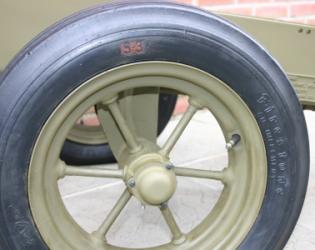
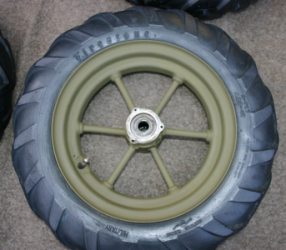
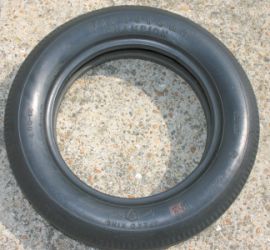
Three most common types of
tires for the M3A4 Hand Carts are shown:
Left: Rib Implement with 'S3'
marking
Center: Ground GripTractor Tread, marked 'MILITARY' and 'SPEED KING'
Right: Champion, marked with both 'S3',
'MILITARY' and 'SPEED KING'
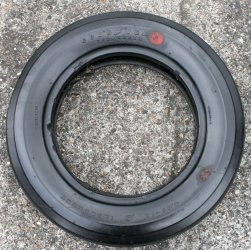
All tires from the Webmaster's Collection
The Good-Year made tire shown above is another type used on the carts. It has the straight rib implement tread generally encountered on Firestone made models. It is marked 'Implement' and 'S-3' with an extra red dot over the '4-Ply' marking.
Cover & Tow Ropes
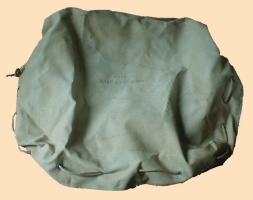
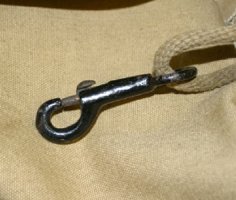
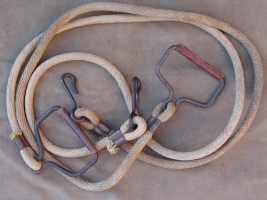
M500 Cover
and Clip from private collections, Tow Ropes from the Webmaster's Collection
The M500
Cover for the M3A4 Hand Cart is a rectangular cover with grommets and a rope
going all around the cover. Each corner is equipped with a clip to
attach the cover to wire loops on the box.
The Tow Ropes are about 6' long and hook up to the loops provided on each
corner of the box. The metal handles are partly covered in leather.
Data Plates & Ordnance Inspector Markings
A Data
Plate showing Type, Make, Serial Number and Year of Manufacture is riveted to
the right side of the box on all M3A4 Hand Carts.
Similar to rifles and other weapons of the US Army during WW2, an Ordnance
Inspector marked all carts upon acceptance. This Acceptance Mark was stamped in
the upper right corner of the dataplate and varied with the different
manufacturers. Since all markings were painted over, it seems these were applied
before final painting...
|
|
Rock
Island Arsenal:
N.F.R. |
The Machine Gun
or Mortar Carts were hardly used in Europe during WW2 and in fact most of the
M4A1, M5A1 and M6A1 variations saw their special brackets removed to return them
to standard M3A4 Utility configuration. Sometimes even the data plates were
altered to change the nomenclature to M3A4.
The plate shown below was fitted to a M5A1 Cal .50 Machine Gun Cart which was
brought back to M3A4 standards. The Cal .50 was also changed into Cal .30

Private Collection Photo
Unit Markings
Although it is
rather uncommon to see hand carts marked in any way, sometimes numbers, tactical
signs or even full unit markings as stipulated in Army Regulations are
encountered.
Click Here
for an excerpt from the 1942 edition AR 850-5 about Unit Identification Markings.
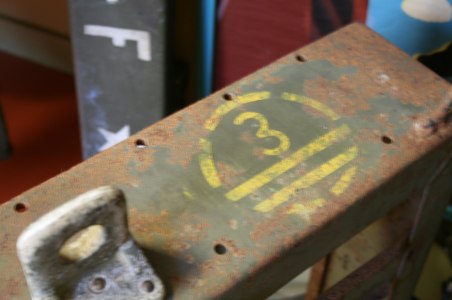
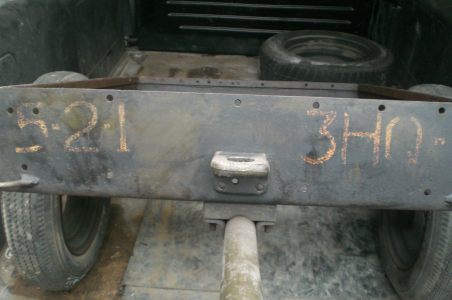
Carts from private collections
A steel hand cart body with Normandy
invasion tactical markings of the 3rd Battalion of the 18th Infantry Regiment of
the 1st Infantry Division (Big Red One) above left and a hand cart marked as 6th
vehicle of Headquarters, 3rd Battalion, 2nd Infantry Regiment of the 5th
Infantry Division on the right. The vehicle number '6' is not visible on this
particular picture but the full marking on the cart body is 5-2-I 3HQ-6
Both carts were used in the European campaign in WW2.
Wartime Images of Hand Carts in use
|
'Pre-War
Maneuvers' |
|
GI's
from the 1st Infantry Division return to their transports at the
conclusion of the August 1941 New River maneuvers in North Carolina. |
|
'Rangers
training in Scotland' |
|
Rangers from the 1st Battalion embark on Landing Craft in
Scotland on October 31st, 1942. |
|
|
'The
Big Red One in North Africa...' A
Jeep from the 1st Infantry Division, tows an early aluminum cart loaded
with a DR-5 communication wire reel. |
|
'Rangers
hauling a 81mm Mortar in North Africa' |
|
Rangers from the 1st Bn haul
their 81mm Mortar and equipment through the streets of Arzew, Algeria, on
November 16th, 1942. |
|
'Operation
Husky' |
|
Vehicles
from the 1st Infantry Division are being unloaded at Gela Beach, Sicily
on 10th July 1943. The Jeep bears markings of the 1st Signal Company of the 1st Division (1-X 1S) and invasion color code bars along with the Signal Company's tactical marking consisting of a yellow three dotted circle have been added to the white tipped front bumper. RL-31 Reel Equipment is mounted on the rear panel of the Jeep. |
|
'Glider
Infantry embarking for Normandy' |
|
Some units of the 327th Glider Infantry Regt, 101 Airborne
Division were part of the Seaborne Force for the Normandy invasion. These
glidermen are about to board their transport ships at Dartmouth/Brixham, England
early June 1944. |
'Embarking for
Omaha-Beach'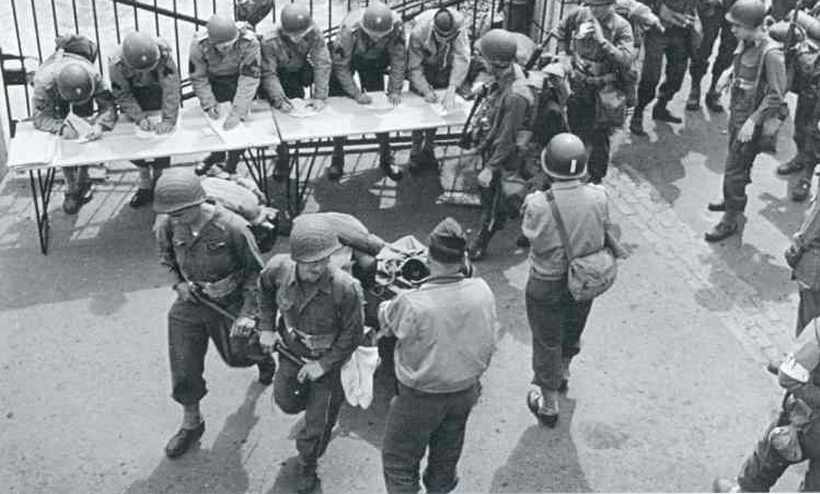 US Army Signal Corps Photo |
| While the markings on the helmets of the Oficers in the back clearly identify them as belonging to the 29th Infantry Division, the GI's pulling the M3A4 Hand Cart are from the 1st Infantry Division. This photo shows first wave assault troops from both divisions embarking for the Normandy invasion early June 1944 and is clear evidence that Hand Carts were not only issued to Airborne troops. |
|
'Two Carts on Utah-Beach...' Two
fully loaded carts on Utah-Beach shortly after the invasion. |
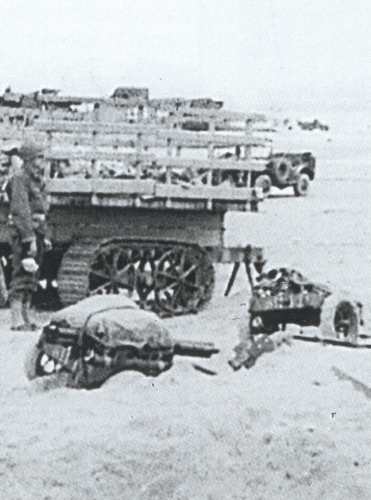 US Army Signal Corps Photo |
'Picking
up equipment bundles from the Drop Zone'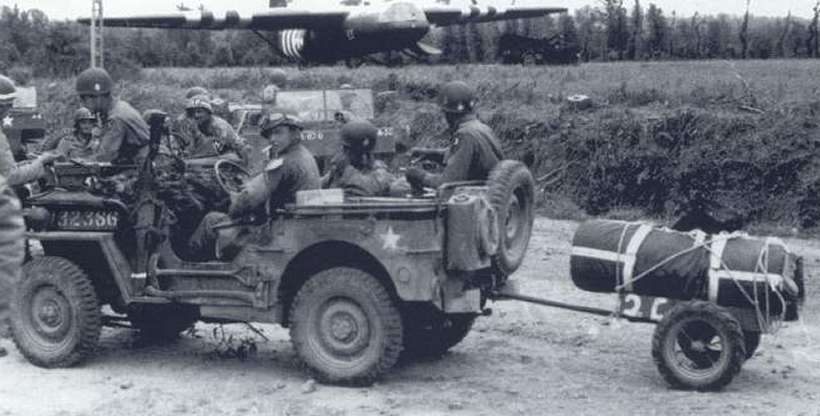 US Army Signal Corps Photo |
|
A Jeep from the 101st Airborne
Division towing a M3A4 Cart loaded with an A5 Equipment Container in
Normandy, June 1944. The cart is equipped with the Firestone tractor tread tires and crudely marked 2C (2nd Platoon, C Company?) In the background M29 'Weasels' are heading inland from Utah-Beach past an apparently undamaged British made Horsa glider. The Horsa was favored by the USAAF for its larger payload... |
|
'Moving Inland...' US
vehicles are moving inland from the landing beaches in France. A M3A4 Hand
Cart with tractor tread tires is strapped upside down on the Bantam Jeep
trailer.. |
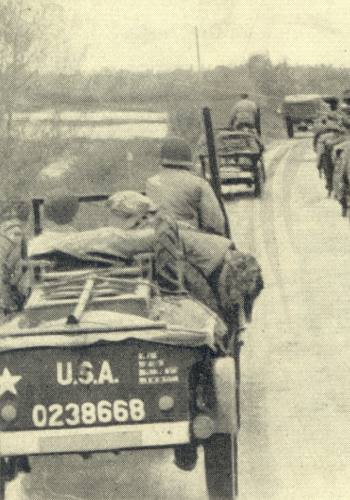 US Army Signal Corps Photo |
|
|
'Carentan'
A few days after D-Day in
Normandy, GIs pull a Utility Cart through the Rue Holgate in Carentan,
France. They are most likely Glidermen from the 101st Airborne Division. |
|
|
'Hedgerow
Country...' Men from the 90th Infantry Division pull a M3A4 Hand Cart loaded with ammunition through the Normandy countrysides in June 1944. The dirt road is bordered by typical hedgerows. |
|
'Mechanics
on the Way' |
|
A Service Co Dodge WC Truck from an unknown unit tows an M3A4 Utility Cart somewhere in France in 1944.
The cart is fitted with
Firestone tractor tread tires and is
loaded with a 4 Cubic Feet Portable Air Compressor used by mechanics to
inflate tires and operate a pneumatic-type grease gun. |
|
'Glider Transported Carts...' This
WACO CG-4A glider 'Dorothy' came down near Kalken, Belgium on its way to
Holland during Operation Market Garden in September 1944. Belgian locals marvel at those unusual transport methods.... |
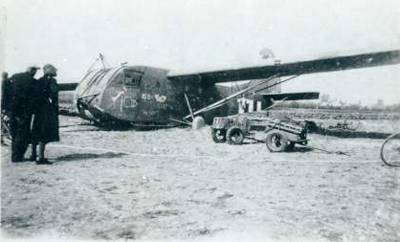 Photo from M. Janssens via BAHAAT |
'Glider
Riders'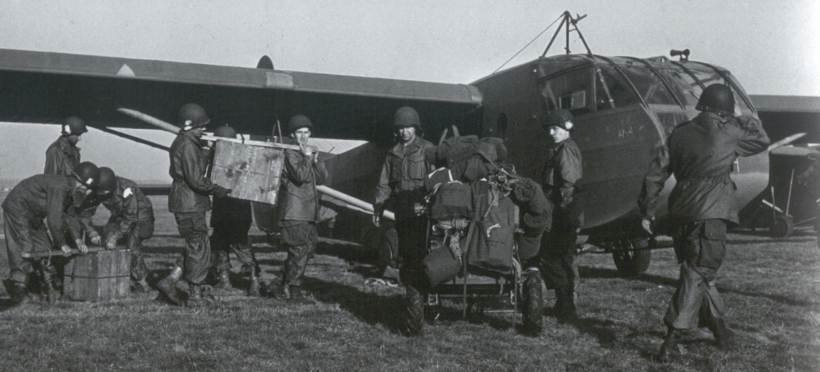 US Army Signal Corps Photo |
| Artillerymen
of the 101st AB Division's 81st AA&AT Battalion load gliders before
being deployed to Holland during Operation Market Garden on September
18th, 1944. An M3A4 Utility Cart with tractor tread tires is packed with ammunition carried in M2 Ammo Bags. |
|
|
'Welcome
to the Liberators...' Infantrymen of the 101st Airborne Division's 327th Glider Infantry are welcomed by a Dutch girl upon leaving the Market Garden Landing Zones in September 1944. Although
not clear the cart might be an M4A1 Machine Gun cart equipped with a
M1917A1 Machine Gun on its tripod. |
'Band of
Brothers' in Holland'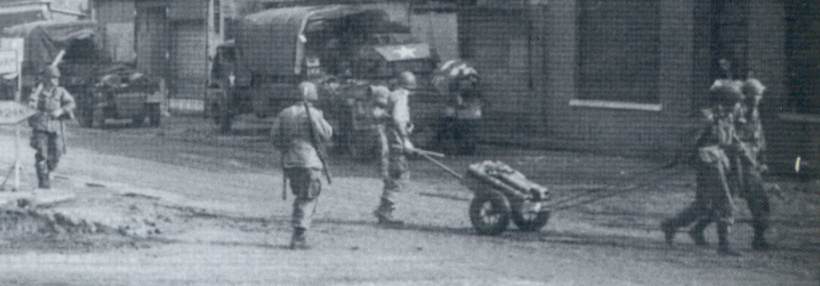 US Army Signal Corps Photo |
|
Paratroopers from the 506th Parachute Infantry Regiment advance
through the Dutch town of Veghel during Operation Market Garden in September
1944. Again two men are pulling the cart with tow ropes while a third trooper
steers from the back. Note the British vehicles from XXXth Corps in the background. |
|
|
'Moving
out.....' GI's from the 101st Airborne Division's 506th Parachute Infantry leave Veghel through the 'Molenstraat' during Operation Market Garden in Holland in September 1944. A Jeep
tows a 1/4Ton Bantam Trailer and an M3A4 Cart as it passes between the marching troops. |
|
'The Ardennes front...' Paratroopers
of the 1st Battalion/504th Regiment of the 82nd Airborne Division use a
cart to transport supplies in the Belgian Ardennes during the Battle of
the Bulge in December 1944. The early aluminum cart seems to be a M6A1 Mortar Cart with the tube carrying bracket bolted to the cart's body. However there are no 81mm Mortar parts visible on the cart. The white marking on the cart seems to be 'HQ' indicating a Headquarters unit. |
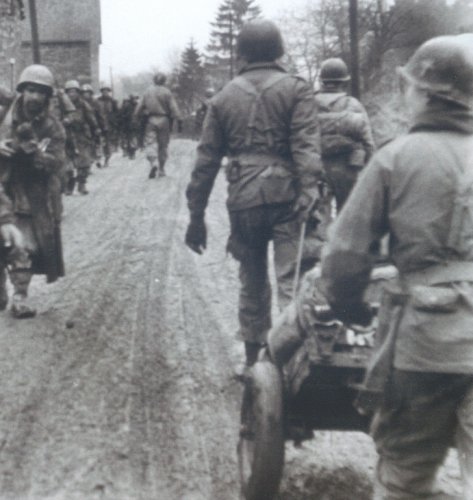 US Army Signal Corps Photo |
|
|
'Into
the heart of Germany...' Men
of the 1st Infantry Division advance into Germany after crossing the Ruhr
in February 1945. |
'Marlene'
having fun with a Hand Cart'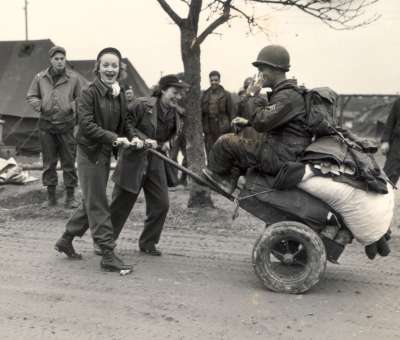 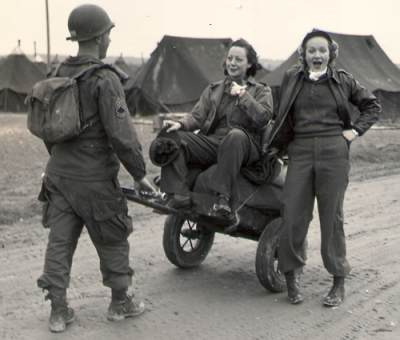 Photos from the Webmaster's Collection |
| During a USO Tour in March
1945, Marlene Dietrich spent some time at Mourmelon, France with the 101st and
17th Airborne Divisions. She was accompanied by actress Lynn Mayberry and these images show them using a M3A4 Hand Cart to move their personal clothing. Ms Mayberry is wearing a Arctic Field Jacket, while Marlene Dietrich sports an A2 Flying Jacket! A Sgt from the 17th AB Div seems to be having the time of his life..... |
'Searching
the Varsity Drop Zone for Supplies'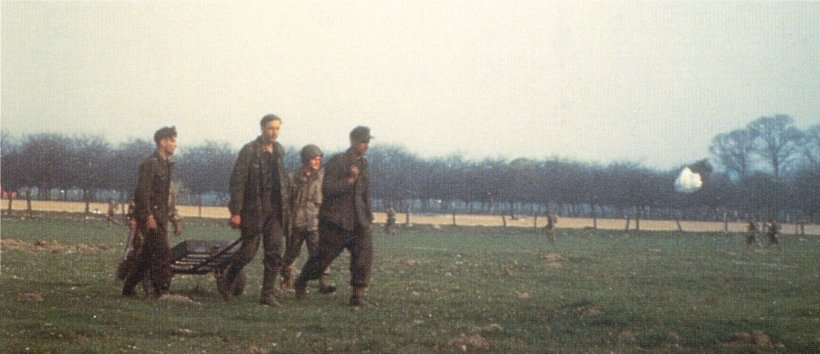 Photo from the Ethell Collection |
| Two
GI's from the 17th Airborne Division and some German POW's with an M3A4
Hand Cart search the field for supplies, while
other paratroopers make their way across the Drop Zone towards their
assembly point after the jump over the Rhine on March 24th, 1945. A white parachute canopy hangs from the trees in the background.... |
Company Roster of I Company-18th Infantry
Original paperwork from the Webmaster's Collection |
|
The above cards were made
up by the CO of I Company/18Infantry Regiment of the 1st Division before an
exercise or operation during WW2. The Company was divided over 6 teams (boats)
and personnel of both I and M Companies are shown on the cards. The cards show that each of the two platoons had 2 Hand Carts to transport their .30Cal Machine Guns. The carts used by this Infantry Company probably came from Battalion HQ, as according to Table of Organization and Equipment (T/O&E) 7-16 , dated 15 July 1943, the Headquarters and Headquarters Company of an Infantry Battalion in an Infantry Division was issued 10 M3A4 carts to be used by the Battalion in landing operations when authorized by the Theater of Operations Commander. |
John Wayne in 'The Longest Day'!
|
Anyone
involved with US WW2 militaria knows the scene from the movie 'The Longest
Day' where John Wayne (playing
LtCol Ben Vandervoort) commandeers a Handcart to ride him into battle with
a broken ankle. |
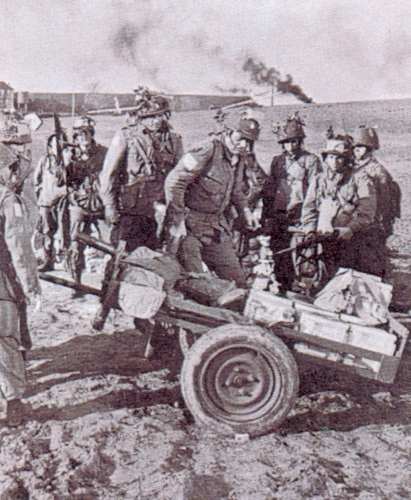 Still from 'The Longest Day', Darryl F Zanuck (1962) |
The real thing ???? Or not????
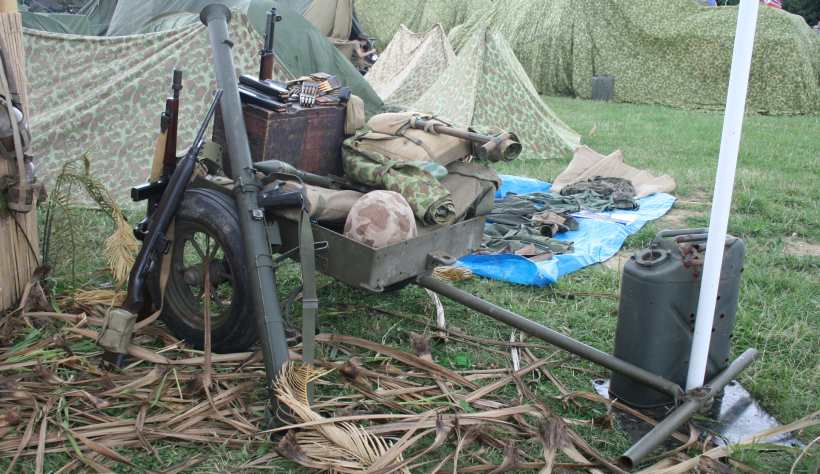
The Cart above displayed at the 2008 Beltring War & Peace Show, is in fact a replica. It is perfect for re-enactments but collectors wanting to buy an original, should do their homework! Caveat Emptor!
Other Carts used by the US Army in the ETO
Two other
carts that were used during WW2 in the European Theater of Operations were the
RL-35 Reel Cart, used to transport Communication Wire Reels and the M1A1
Chemical Mortar Cart, used by the Chemical Mortar Battalions to transport their
heavy 4.2 Inch Chemical Mortars.
While the M1A1 is practically impossible to find, dozens of Reel Carts found
their way into collector's hands after several European Armed Forces sold off their
stock in the
late 1990's
Signal Corps Reel Cart RL-35
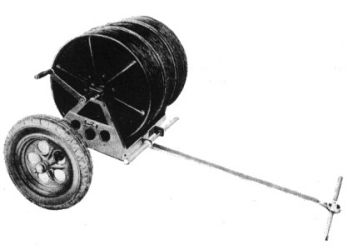
Scan from US Army Field Manual FM24-20 Field Wire
Systems
The image from the manual above shows the Signal Corps RL-35(A) Reel Cart loaded with 3 DR-4 Wire Reels
Below are some rare images of Reelcarts being used in WW2.
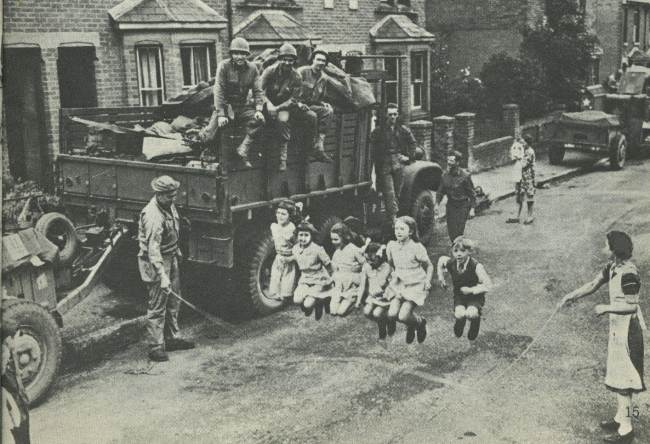
US Army Signal Corps Picture
GIs from the 955th Field Artillery Battalion entertain British children while underway to their embarkation points for the Normandy invasion in Southern England, late May 1944. A Reelcart can be seen loaded on the frame of the M10 Ammunition Trailer towed by the 4-Ton 6x6 Diamond-T Truck.
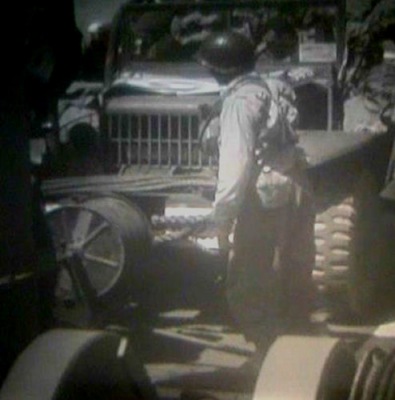
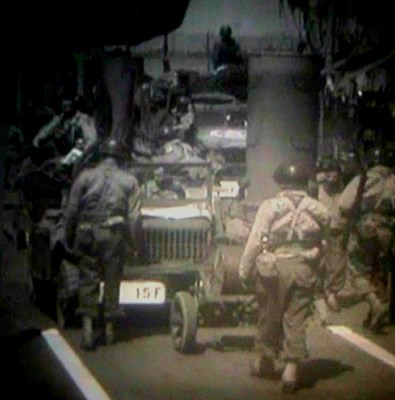
Stills from US Army Signal Corps Film Reels
Two images showing a GI
from the US 1st Infantry Division's 5th Artillery, loading a Reelcart onto a
Landing Craft in preparation of the invasion of France in June 1944.
At the time of the Normandy invasion in June 1944, Engineer and Artillery
Battalions of Infantry Divisions were issued Reel Carts for wire
laying purposes.
Still from US Army Signal Corps Film Reels
A Reelcart towed behind a Jeep on the road towards Cherbourg, France in June 1944.
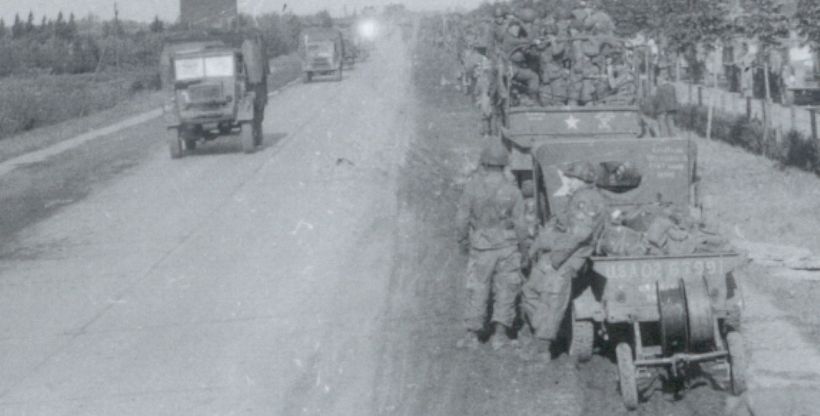
Photo taken by J.
Reeder and published in the 2012 book:
'Orange
is the Color of the Day'
During
Operation Market Garden in
early October 1944, the 506th Parachute Infantry moved from Uden to
Nijmegen.
The column has come to a halt in Grave; a Reelcart loaded with two DR-4 reels is
clearly visible on the right.
The cart is attached to a 1/4 Ton Jeep Trailer by means of an extra towing hook
bolted to the trailer's frame.
The addition of towing hooks to the back of Jeep trailers seems to have been
rather common within the 101st AB Division in the fall of 1944.
A Tandem Trailer Kit was available near the end of WW2, and that included an
extra socket box to be mounted on the right rear of the trailer, which is not
fitted here.
RL-35A Ser#1255
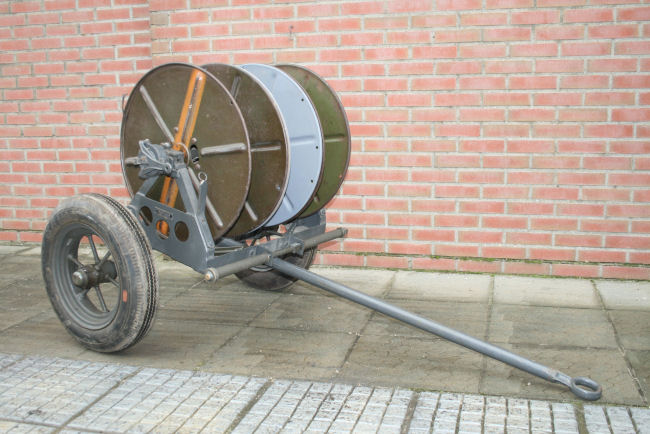
The above RL-35A Ser#1255
was made by the Johnston Lawn Mower Company in 1944 and was added to the
collection in September 2010.
It saw service with the Swiss Army after WW2
and except for a gray repaint it was left completely original and was restored in
2011...
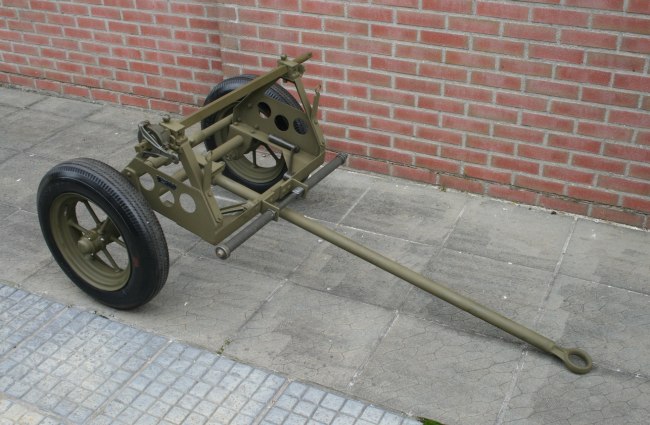
M1A1 Chemical Mortar Cart
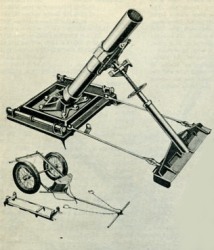
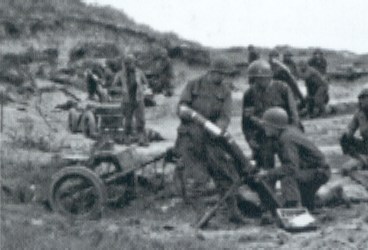
Scan from TM 9-2300 Artillery Material
and Associated Equipment & US Army Signal Corps Photo
Due to its weight of over 300
Lbs, a Cart was needed to transport the 4.2 Inch Chemical Mortar and its ammunition. Troops of the
87th Chemical Mortar Bn fire their weapon from the dunes on Utah-Beach in
support of the 4th Infantry Division on D-Day in Normandy.
Note the 18" Motorcycle Wheels on the M1A1 Cart!
For more images and
information about US Army Hand Carts, visit Craig Johnson's excellent
website at:
www.handcartz.com
Go to the next page for more information about the restoration of my M3A4 Hand Cart.